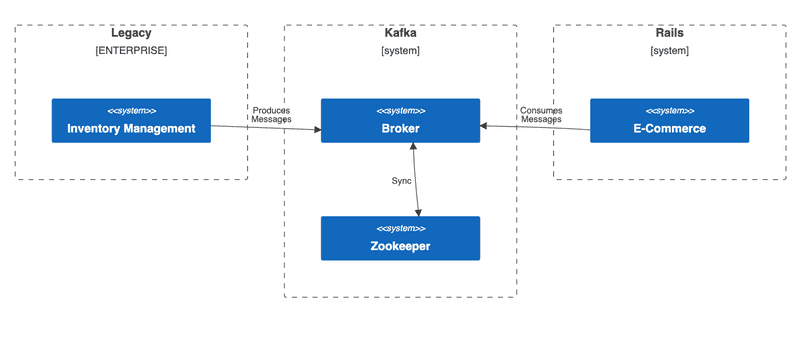Add a Kafka Consumer to Rails

This post will walk through how to integrate a Kafka consumer into a Rails application in a maintainable and testable way. Why would you need to do this? Consider the following scenario: You're working on an e-commerce system that has been developed with Rails. The product details page needs to be enhanced to show whether the current product is in stock, out of stock, or only has small number of items left (eg: "Only 3 left in stock!"). This information comes from a legacy inventory management system that has been written in a different programming language. This legacy system is responsible for updating the inventory count based on events, such as product purchases, returns, or stock replenishments.
In order to display this inventory information in the Rails e-commerce app, it needs the ability to communicate with the legacy inventory system. There are many solutions for enabling different systems to communicate, each with tradeoffs to consider. This post will demonstrate how Apache Kafka can be used to solve this problem. Kafka is a distributed streaming platform that enables high-throughput, fault-tolerant, and real-time event data streaming for building scalable and event-driven applications.
Given that the inventory information is updated based on business events, this makes it a good fit to integrate with Kafka, which is designed for event-driven systems. Using Kafka will make the integration between the legacy and e-commerce system more tolerant to large bursts of inventory events, whereas a REST/HTTP based integration might be prone to information loss in the case of temporary network or database outages.
Big Picture
Conceptually, here is what we'll be building:

We'll be focusing on the Rails side of things. Assume that another team is maintaining the inventory management system and they've already modified it to produce JSON formatted messages every time there's an inventory change. Here's an example message showing that the product identified by product code ABCD1234 has 23 units left in stock:
{
"product_code": "ABCD1234",
"inventory_count": 23
}These messages will be produced to a Kafka topic named inventory_management_product_updates. When integrating Kafka, it's important for all the teams involved to agree on the topic name(s) and message formats, essentially agreeing on a "contract". This will ensure that the disparate systems can communicate with each other as expected.
Rails Product
For this demo, I used Ruby 3.1.2, Rails 7.x and the default options for a new project:
ruby --version
# ruby 3.1.2
rails --version
# Rails 7.0.4.3
rails new karafka_rails_consumer_demo
cd karafka_rails_consumer_demo
bin/rails generate model product name:string code:string price:decimal inventory:integerThe Rails application has a products table to store the product name, product code, price, and inventory count. Here is the migration:
# db/migrate/20230524104551_create_products.rb
class CreateProducts < ActiveRecord::Migration[7.0]
def change
create_table :products do |t|
t.string :name, null: false
t.string :code, null: false
t.decimal :price, null: false, precision: 8, scale: 2
t.integer :inventory, null: false, default: 0
t.timestamps
end
end
endHere is the corresponding Product model with some validations added. I'm using the annotate gem to automatically generate schema information as comments in the model class when migrations are run via bin/rails db:migrate:
# app/models/product.rb
# == Schema Information
#
# Table name: products
#
# id :integer not null, primary key
# code :string not null
# inventory :integer default(0), not null
# name :string not null
# price :decimal(8,2) not null
# created_at :datetime not null
# updated_at :datetime not null
#
class Product < ApplicationRecord
validates :name, presence: true
validates :code, presence: true
validates :price, presence: true
validates :inventory, presence: true, numericality: { greater_than_or_equal_to: 0 }
def inspect
"#<Product id: #{id}, name: #{name}, code: #{code}, price: #{formatted_price}, inventory: #{inventory}>"
end
def formatted_price
format("%.2f", price)
end
endIn development, the products table is populated with seed data, using the faker gem:
# db/seeds.rb
require "faker"
if Rails.env.development?
Product.destroy_all
20.times do
Product.create!(
name: Faker::Commerce.product_name,
code: "#{Faker::Alphanumeric.alpha(number: 4).upcase}#{Faker::Number.number(digits: 4)}",
price: Faker::Commerce.price(range: 0..100.0),
inventory: rand(0..50)
)
end
else
puts "Seeding skipped. Not in development environment."
endThe products can be viewed in a Rails console bin/rails c
Product.all
#<Product id: 41, name: Awesome Wool Gloves, code: JANW7810, price: 47.53, inventory: 10>,
#<Product id: 42, name: Durable Steel Plate, code: BMJG7868, price: 96.25, inventory: 3>,
#<Product id: 43, name: Ergonomic Paper Bag, code: FLMA2165, price: 52.46, inventory: 6>,
...Install Kafka
Even though we'll be focused on consuming messages in the Rails application, we're going to need to produce messages to try it out. This means we'll need access to a Kafka cluster, which includes one or more brokers, and Zookeeper to manage the cluster. While you could point to a shared cluster if your organization manages their own or uses Confluent (Kafka as a service), I prefer to think of this similar to a database. In the same way that every developer working on a Rails application has their own local database installed, Kafka is also a kind of database (specifically, a raw, distributed database). It could get messy if all developers are pointing to a shared cluster, producing test messages that end up getting consumed by other developers running their own tests.
The easiest way to set up a Kafka cluster locally is with Docker and docker-compose. Confluent provides these images in their cp-all-in-one repository. Just two containers are required for a minimal cluster - a broker, and a zookeeper instance. Add the following docker-compose.yml file to the root of the project:
---
version: '2'
services:
zookeeper:
image: confluentinc/cp-zookeeper:7.2.1
hostname: zookeeper
ports:
- "2181:2181"
environment:
ZOOKEEPER_CLIENT_PORT: 2181
ZOOKEEPER_TICK_TIME: 2000
broker:
image: confluentinc/cp-server:7.2.1
hostname: broker
depends_on:
- zookeeper
ports:
- "9092:9092"
- "9101:9101"
environment:
KAFKA_BROKER_ID: 1
KAFKA_ZOOKEEPER_CONNECT: 'zookeeper:2181'
KAFKA_LISTENER_SECURITY_PROTOCOL_MAP: PLAINTEXT:PLAINTEXT,PLAINTEXT_HOST:PLAINTEXT
KAFKA_ADVERTISED_LISTENERS: PLAINTEXT://broker:29092,PLAINTEXT_HOST://localhost:9092
KAFKA_METRIC_REPORTERS: io.confluent.metrics.reporter.ConfluentMetricsReporter
KAFKA_OFFSETS_TOPIC_REPLICATION_FACTOR: 1
KAFKA_GROUP_INITIAL_REBALANCE_DELAY_MS: 0
KAFKA_CONFLUENT_LICENSE_TOPIC_REPLICATION_FACTOR: 1
KAFKA_CONFLUENT_BALANCER_TOPIC_REPLICATION_FACTOR: 1
KAFKA_TRANSACTION_STATE_LOG_MIN_ISR: 1
KAFKA_TRANSACTION_STATE_LOG_REPLICATION_FACTOR: 1
KAFKA_JMX_PORT: 9101
KAFKA_JMX_HOSTNAME: localhost
CONFLUENT_METRICS_REPORTER_BOOTSTRAP_SERVERS: broker:29092
CONFLUENT_METRICS_REPORTER_TOPIC_REPLICAS: 1
CONFLUENT_METRICS_ENABLE: 'true'
CONFLUENT_SUPPORT_CUSTOMER_ID: 'anonymous'To start the containers, run:
docker-compose upGive it a few seconds to start, then check on the status in another terminal tab:
docker-compose psIf all is well, the output should look something like this, showing that both zookeeper and a single broker are running, with the broker exposed on port 9092:
Name Command State Ports
----------------------------------------------------------------------------------------------------------------------------
karafka_rails_consumer_demo_broker_1 /etc/confluent/docker/run Up 0.0.0.0:9092->9092/tcp, 0.0.0.0:9101->9101/tcp
karafka_rails_consumer_demo_zookeeper_1 /etc/confluent/docker/run Up 0.0.0.0:2181->2181/tcp, 2888/tcp, 3888/tcpAdd Karafka Gem
The Rails application needs to be enhanced so that it can consume messages from the inventory_management_product_updates Kafka topic. We're going to use the Karafka gem to make the integration relatively easy. Some of the benefits of this gem include:
- Abstracts complexities of working directly with the Kafka protocol.
- Leverages multithreading to achieve concurrency and high performance.
- Integrates easily with Rails, following routing style conventions.
- Built in error handling and retry logic.
- Testing utilities that make it easy to write automated tests for consumers and producers.
- Provides both an open source and pro version with additional advanced features.
To get started with Karafka, add the following to the project's Gemfile and then run bundle install:
gem "karafka", ">= 2.0.34"Next run the karafka installation command which will setup some initial scaffolding:
bundle exec karafka installThis command will generate the main Karafka entrypoint file karafka.rb with some basic configuration, and an example topic and consumer:
# karafka.rb
class KarafkaApp < Karafka::App
setup do |config|
config.kafka = { "bootstrap.servers": "127.0.0.1:9092" }
config.client_id = "example_app"
config.consumer_persistence = !Rails.env.development?
end
routes.draw do
topic :example do
consumer ExampleConsumer
end
end
endModify this file by replacing the example topic with the inventory_management_product_updates topic in the routes.draw block, and the example consumer with ProductInventoryConsumer (to be implemented shortly):
class KarafkaApp < Karafka::App
# config block...
routes.draw do
topic :inventory_management_product_updates do
consumer ProductInventoryConsumer
end
end
endNow let's implement the ProductInventoryConsumer class. This is a class that inherits from ApplicationConsumer, which was also generated from the karafka installation command. The only method that's required to be implemented in a consumer class is the consume method, which will be invoked by Karafka with a batch of messages. For now, we will only log the message payload and offset to confirm messages are being received. The consume method also has access to the topic so let's log the topic name as well:
# app/consumers/product_inventory_consumer.rb
class ProductInventoryConsumer < ApplicationConsumer
def consume
messages.each do |message|
Rails.logger.info(
"ProductInventoryConsumer consuming Topic: #{topic.name}, \
Message: #{message.payload},\
Offset: #{message.offset}"
)
end
end
endTo exercise this code, open a new terminal tab and run:
bundle exec karafka serverThis command initializes the Karafka application defined at karafka.rb, connects to the Kafka cluster specified by the bootstrap.servers config, starts consuming messages from the topics specified in the routes.draw block, and invokes the configured consumer classes to process those messages. The server will continuously listen for new messages until the process is terminated. The output of this command is as follows:
Running Karafka 2.1.0 server
See LICENSE and the LGPL-3.0 for licensing details
[00f6800d4770] Polling messages...
[00f6800d4770] Polled 0 messages in 47.48299999954179ms
[00f6800d4770] Polling messages...
[00f6800d4770] Polled 0 messages in 1000.3159999996424ms
...In order to exercise the ProductInventoryConsumer code, messages need to be produced to the inventory_management_product_updates topic. In production, this will be done by the inventory management system. For local development, we don't have that system running on our laptops. Fortunately, Karafka can also be used to produce messages. Let's try this out by launching a Rails console bin/rails c in another terminal tab and then enter the following code:
# Generate a message with the expected attributes in JSON format:
message = {
product_code: Product.first.code,
inventory_count: 10
}.to_json
# => "{\"product_code\":\"JANW7810\",\"inventory_count\":10}"
# Produce and send a message to the `inventory_management_product_updates` topic:
Karafka.producer.produce_async(topic: 'inventory_management_product_updates', payload: message)
# [ce1340a60c42] Async producing of a message to '
# inventory_management_product_updates' topic took 21.07400000002235 ms
# [ce1340a60c42] {:topic=>"inventory_management_product_updates",
# :payload=>"{\"product_code\":\"JANW7810\",\"inventory_count\":10}"}After submitting the producer command, the terminal tab running the Karafka server will log output indicating the message has been consumed from topic inventory_management_product_updates and offset 0. I've added some === EXPLANATIONS ===:
=== KARAFKA LOGGING WHEN CONSUMER STARTS PROCESSING ===
[50b2762f16b2] Consume job for ProductInventoryConsumer on
inventory_management_product_updates/0 started
=== CONSUMER INFO LEVEL LOGGING ===
ProductInventoryConsumer consuming: Topic: inventory_management_product_updates,
Message: {"product_code"=>"JANW7810", "inventory_count"=>10}, Offset: 0
=== KARAFKA LOGGING WHEN CONSUMER FINISHES PROCESSING ===
[50b2762f16b2] Consume job for ProductInventoryConsumer on
inventory_management_product_updates/0 finished in 345.4149999995716msWhen there's a batch of messages ready to be processed, the consume method gets invoked with the messages, which can be iterated (in our simple case, there's only one message currently). Each of these is an instance of Karafka::Messages::Message. When the payload method is invoked on the message object, Karafka will deserialize it, which converts the raw Kafka message to a format you can work with in your Ruby code. By default, it uses JSON deserialization, which means it assumes the messages are in JSON format, and they will be deserialized into a Ruby hash. This is what's shown in the console output when we log message.payload. The Karafka docs have more details about deserialization.
Update Product
Now that we know we can produce and consume messages with Kafka, it's time to do the actual work of updating the product inventory. We saw from the previous exercise that a message like this:
"{\"product_code\":\"JANW7810\",\"inventory_count\":10}"Gets deserialized to a Ruby hash when the payload method is invoked on it:
{
"product_code" => "JANW7810",
"inventory_count" => 10
}This means the product code and inventory count can be accessed within the consumer as follows:
# app/consumers/product_inventory_consumer.rb
class ProductInventoryConsumer < ApplicationConsumer
def consume
messages.each do |message|
# Deserialize JSON message into a hash assigned to `payload`
payload = message.payload
# Access payload attributes
puts "Product code = #{payload['product_code']}" # JANW7810
puts "Inventory count = #{payload['inventory_count']}" # 10
end
endSo updating the product inventory count could be done directly in the consumer like this:
class ProductInventoryConsumer < ApplicationConsumer
def consume
messages.each do |message|
payload = message.payload
product = Product.find_by(code: payload["product_code"])
product.update!(inventory: payload["inventory_count"])
end
end
endThere are some problems with this approach as will be covered shortly, but first, let's exercise this version of the consumer to verify it works. Back in the Rails console, run the code shown below to check the inventory value of the first product, then produce a message to update it to a different value:
# Check what the current inventory value is for the first product
Product.first.inventory
# 20
# Produce a message to update it to a different value
message = {
product_code: Product.first.code,
inventory_count: 123
}.to_json
Karafka.producer.produce_async(topic: 'inventory_management_product_updates', payload: message)Now the tab running the Karafka server (consumer polling for messages), will show that the message has been received and the product inventory has been updated:
=== KARAFKA LOGGING WHEN CONSUMER STARTS PROCESSING ===
[d886a13043fd] Consume job for ProductInventoryConsumer on
inventory_management_product_updates/0 started
=== RAILS DEV LOGGING FROM FINDING AND UPDATING PRODUCT ===
Product Load (0.9ms) SELECT "products".* FROM "products"
WHERE "products"."code" = ? LIMIT ? [["code", "JANW7810"], ["LIMIT", 1]]
↳ app/consumers/product_inventory_consumer.rb:5:in `block in consume'
TRANSACTION (0.2ms) begin transaction
↳ app/consumers/product_inventory_consumer.rb:6:in `block in consume'
Product Update (0.4ms) UPDATE "products" SET "inventory" = ?, "updated_at" = ?
WHERE "products"."id" = ? [["inventory", 123], ["updated_at", "2023-06-02 11:10:00.738034"], ["id", 41]]
↳ app/consumers/product_inventory_consumer.rb:6:in `block in consume'
TRANSACTION (2.1ms) commit transaction
↳ app/consumers/product_inventory_consumer.rb:6:in `block in consume'
=== KARAFKA LOGGING WHEN CONSUMER FINISHES PROCESSING ===
[d886a13043fd] Consume job for ProductInventoryConsumer on
inventory_management_product_updates/0 finished in 23.927999999839813msBack in the Rails console, fetch the product again and check its inventory count, it should be 123 from the Kafka message produced and consumed earlier:
Product.first.inventory
# 123Great it's working, ship it!
Not so fast...
What Could Possibly Go Wrong?
In the previous section, we saw the happy path working. Now its time to think about things that could go wrong.

For example, what if the inventory system sends a product code that the Rails e-commerce system doesn't have in its records? This could happen if the legacy system also manages in-store products that are not sold online, or maybe its buggy and no one quite understands how it works. Let's simulate this situation by producing a message in the Rails console for a non existing product code:
message = {
product_code: "NO-SUCH-CODE",
inventory_count: 123
}.to_json
Karafka.producer.produce_async(topic: 'inventory_management_product_updates', payload: message)Keep an eye on the terminal tab running the Karafka server, it will show a stack trace from attempting to consume this message:
[d886a13043fd] Consume job for ProductInventoryConsumer on
inventory_management_product_updates/0 started
Product Load (0.5ms) SELECT "products".* FROM "products"
WHERE "products"."code" = ? LIMIT ? [["code", "NO-SUCH-CODE"], ["LIMIT", 1]]
↳ app/consumers/product_inventory_consumer.rb:5:in `block in consume'
Consumer consuming error: undefined method `update!' for nil:NilClass
product.update!(inventory: payload["inventory_count"])
^^^^^^^^
/path/to/app/consumers/product_inventory_consumer.rb:6:in `block in consume'
/path/to/gems/karafka-2.1.0/lib/karafka/messages/messages.rb:22:in `each'
/path/to/gems/karafka-2.1.0/lib/karafka/messages/messages.rb:22:in `each'
/path/to/app/consumers/product_inventory_consumer.rb:3:in `consume'What's happening is that nil is returned from the find_by method, then it errors out attempting to call the update! method on the nil return:
# app/consumers/product_inventory_consumer.rb
# This line returns `nil` when called with `code: "NO-SUCH-CODE"`
product = Product.find_by(code: payload["product_code"])
# Which results in undefined method `update!` for nil:NilClass here
product.update!(inventory: payload["inventory_count"])If you let the Karafka server keep running, you'll see the stack trace repeat several times, at increasing intervals of time. This is because Karafka's default behaviour is to keep retrying the failed message if an error is raised, according to a back-off strategy, up until a maximum value of 30,000 ms is reached (30 seconds), at which point, it will keep trying every 30 seconds:
[1bcb7660af45] Pausing on topic inventory_management_product_updates/0 on offset 1
[d854346b76bf] Retrying of ProductInventoryConsumer after 2000 ms on topic inventory_management_product_updates/0 from offset 1
...
[1bcb7660af45] Pausing on topic inventory_management_product_updates/0 on offset 1
[8d4c56ce8e62] Retrying of ProductInventoryConsumer after 8000 ms on topic inventory_management_product_updates/0 from offset 1
...
[1bcb7660af45] Pausing on topic inventory_management_product_updates/0 on offset 1
[15a4dead41b2] Retrying of ProductInventoryConsumer after 16000 ms on topic inventory_management_product_updates/0 from offset 1
...
[1bcb7660af45] Pausing on topic inventory_management_product_updates/0 on offset 1
[8f894960f0ac] Retrying of ProductInventoryConsumer after 30000 ms on topic inventory_management_product_updates/0 from offset 1
...
# keeps retrying every 30000 msThis behaviour is controlled by the following config settings, which get assigned default values. Here's a snippet from the Karafka source Karafka::Setup::Config:
# option [Boolean] should we use exponential backoff
setting :pause_with_exponential_backoff, default: true
# option [Integer] what is the max timeout in case of an exponential backoff (milliseconds)
setting :pause_max_timeout, default: 30_000Without error handling, it will keep trying to process this message, and not move on to other messages (because the offset of the bad message will not be committed). So clearly, some error handling is needed.
Dead Letter Queue
In terms of writing the least amount of application code, the easiest way to get error handling with Karafka is to configure a Dead Letter Queue (DLQ) per each topic. For example:
# karafka.rb
class KarafkaApp < Karafka::App
# config block...
routes.draw do
topic :inventory_management_product_updates do
consumer ProductInventoryConsumer
dead_letter_queue(
# name this as per your organization's naming conventions
topic: "dlq_inventory_management_product_updates",
max_retries: 2
)
end
end
endWith this approach, if any error is raised during message processing, Karafka will automatically retry up to a configured number of max_retries (which can also be set to zero if you don't ever want it to retry). If message processing still fails after the retries are exhausted, a new message containing the same header and payload as the troublesome message will be produced to the topic specified in the dead_letter_queue method, in this case, dlq_inventory_management_product_updates.
With the modified karafka.rb in place (remember to restart the karafka server bundle exec karafka server after making changes to karafka.rb), producing an inventory update message with a product code that does not exist will generate the following log messages in the Karafka server. I've annotated them with === EXPLANATION ===, which shows that after consuming the bad message, Karafka will make two more attempts to process it. If those still fail, it writes the message the the topic dlq_inventory_management_product_updates, then moves on, waiting to consume new messages:
=== START CONSUMING BAD MESSAGE ===
[d13504295353] Consume job for ProductInventoryConsumer on
inventory_management_product_updates/0 started
Product Load (0.2ms) SELECT "products".* FROM "products"
WHERE "products"."code" = ? LIMIT ? [["code", "NO_SUCH_CODE"], ["LIMIT", 1]]
↳ app/consumers/product_inventory_consumer.rb:5:in `block in consume'
Consumer consuming error: undefined method `update!' for nil:NilClass
product.update!(inventory: payload["inventory_count"])
^^^^^^^^
/path/to/app/consumers/product_inventory_consumer.rb:6:in `block in consume'
...stack trace...
=== FIRST RETRY ===
[fa875ec2db84] Retrying of ProductInventoryConsumer after 2000 ms on
topic inventory_management_product_updates/0 from offset 1
[d13504295353] Consume job for ProductInventoryConsumer on
inventory_management_product_updates/0 started
Product Load (0.1ms) SELECT "products".* FROM "products"
WHERE "products"."code" = ? LIMIT ? [["code", "NO_SUCH_CODE"], ["LIMIT", 1]]
↳ app/consumers/product_inventory_consumer.rb:5:in `block in consume'
Consumer consuming error: undefined method `update!' for nil:NilClass
product.update!(inventory: payload["inventory_count"])
^^^^^^^^
/path/to/app/consumers/product_inventory_consumer.rb:6:in `block in consume'
...stack trace...
=== SECOND RETRY ===
[76694e052832] Retrying of ProductInventoryConsumer after 4000 ms on
topic inventory_management_product_updates/0 from offset 1
[d13504295353] Consume job for ProductInventoryConsumer on
inventory_management_product_updates/0 started
Product Load (0.2ms) SELECT "products".* FROM "products"
WHERE "products"."code" = ? LIMIT ? [["code", "NO_SUCH_CODE"], ["LIMIT", 1]]
↳ app/consumers/product_inventory_consumer.rb:5:in `block in consume'
Consumer consuming error: undefined method `update!' for nil:NilClass
product.update!(inventory: payload["inventory_count"])
^^^^^^^^
/path/to/app/consumers/product_inventory_consumer.rb:6:in `block in consume'
...stack trace...
=== WRITE BAD MESSAGE TO DLQ ===
[23c9519eb294] Async producing of a message to
'dlq_inventory_management_product_updates' topic took 1.7790000000968575 ms
[23c9519eb294] {:topic=>"dlq_inventory_management_product_updates",
:payload=>"{\"product_code\":\"NO_SUCH_CODE\",\"inventory_count\":5}"}
[d1e59c1bd1df] Dispatched message 1 from inventory_management_product_updates/0
to DLQ topic: dlq_inventory_management_product_updates
=== OFFSET COMMITTED, READY TO PROCESS MORE MESSAGES ===
[316f38a98a31] Pausing on topic inventory_management_product_updates/0 on offset 2
[bc51bb551a3f] Polling messages...Error Monitoring
It's also useful to capture the error messages and stack traces in your error tracking/monitoring tool of choice (Sentry, Rollback, etc.). Karafka provides a monitoring API that allows you to subscribe to instrumentation events, and deal with them as you wish.
Add this block to the karafka.rb file in the project root, between the configuration block and the routes to extract the error object and stack trace from the event and log them. Additionally here is where you would log to whatever error monitoring service you use:
# frozen_string_literal: true
class KarafkaApp < Karafka::App
setup do |config|
# config...
end
# Common error handling example
Karafka.monitor.subscribe "error.occurred" do |event|
type = event[:type]
error = event[:error]
details = (error.backtrace || []).join("\n")
Rails.logger.error("An error: #{error} of type: #{type} occurred, details: #{details}")
# Or whatever error monitoring service Airbrake, Rollbar, etc.
Sentry.capture_exception(error)
end
routes.draw do
# topics and consumers...
end
endNow whenever an error occurs in the consumer, the message and stack trace will get logged, and additionally you can notify whatever error monitoring service you use such as Sentry, Rollbar, etc. The message that caused the error will still get produced to the DLQ as per the topic configuration.
While we could use the DLQ, together with Karafka's built-in error monitoring and simply let Karafka deal with all errors, it will be cleaner to also have the business logic be more resilient, and ensure the system produces useful error messages. Otherwise some poor soul in production support is going to be dealing with a bunch of failed messages in the dead letter queue and have no idea what's gone wrong. That could be you if developers are also responsible for production support at your company!
The other issue with this approach is there's some wasted processing with the retries. For example, if the product code does not exist in the e-commerce system, there's no point retrying the message because it still won't exist. While this can be mitigated by setting max_retries: 0, there could be other errors which should be retried such as if a network blip occurs and the database is temporarily unreachable.
Validation in Consumer
As a first attempt at making the code more resilient, the consumer could be modified to check if the product exists, before attempting an update, otherwise log an error and manually dispatch to the dead letter queue (Karafka will only automatically produce a message to the DLQ when an exception is raised):
class ProductInventoryConsumer < ApplicationConsumer
def consume
messages.each do |message|
payload = message.payload
product = Product.find_by(code: payload["product_code"])
if product.present?
product.update!(inventory: payload["inventory_count"])
else
Rails.logger.error("Product #{payload['product_code']} does not exist")
dispatch_to_dlq(message)
end
end
end
endWith this in place, producing a message with an non-existing product code will result in logging an error, and the invalid message dispatched to the dead letter queue without any retries. Here's what this looks like in the Karafka server logs, again I've added === EXPLANATIONS ===:
=== START CONSUMING MESSAGE ===
[ce8640c13bf0] Polled 1 messages in 1004.0149999996647ms
[ac5cf1c6d557] Consume job for ProductInventoryConsumer
on inventory_management_product_updates/0 started
=== CHECK IF PRODUCT EXISTS ===
Product Load (0.4ms) SELECT "products".* FROM "products"
WHERE "products"."code" = ? LIMIT ? [["code", "NO_SUCH_CODE"], ["LIMIT", 1]]
↳ app/consumers/product_inventory_consumer.rb:5:in `block in consume'
=== RAILS LOGGER ERROR ===
Product NO_SUCH_CODE does not exist
=== DISPATCH TO DQL ===
[12cb723b4056] Async producing of a message to
'dlq_inventory_management_product_updates' topic took 0.9180000005289912 ms
[12cb723b4056] {:topic=>"dlq_inventory_management_product_updates",
:payload=>"{\"product_code\":\"NO_SUCH_CODE\",\"inventory_count\":5}"}
[89c41457fc4c] Dispatched message 2 from
inventory_management_product_updates/0 to DLQ topic: dlq_inventory_management_product_updates
[ac5cf1c6d557] Consume job for ProductInventoryConsumer on
inventory_management_product_updates/0 finished in 275.4199999999255ms
=== READY FOR MORE MESSAGES ===
[ce8640c13bf0] Polling messages...While this works, the consumer is starting to get a little messy. And it will continue to get messier as more validation rules are enforced. For example, in the e-commerce system, there's a constraint that the inventory count must be greater than zero, recall the product model has:
# app/models/product.rb
class Product < ApplicationRecord
# other validations...
validates :inventory, presence: true, numericality: { greater_than_or_equal_to: 0 }
endSuppose the inventory management system could send negative inventory counts, or blank values. It might do this if the business rules in the legacy system are different than those in the e-commerce system, or again, it could be buggy and not enough time/people to deal with the legacy system quirks. The consumer could be modified to handle this case as well:
class ProductInventoryConsumer < ApplicationConsumer
def consume
messages.each do |message|
payload = message.payload
product = Product.find_by(code: payload["product_code"])
if product.present?
if payload["inventory_count"] >= 0
product.update!(inventory: payload["inventory_count"])
else
Rails.logger.error("Inventory count cannot be negative")
dispatch_to_dlq(message)
end
else
Rails.logger.error("Product #{payload['product_code']} does not exist")
dispatch_to_dlq(message)
end
end
end
endAt this point, if the project is using Rubocop with a default configuration, this code will light up with some offenses warning that the complexity of the consume method is too high and that the method is too long:
app/consumers/product_inventory_consumer.rb:2:3:C: Metrics/AbcSize:Assignment
Branch Condition size for consume is too high. [<3, 16, 6> 17.35/17]
def consume ...
^^^^^^^^^^^
app/consumers/product_inventory_consumer.rb:2:3: C: Metrics/MethodLength:
Method has too many lines. [15/10]
def consume ...
^^^^^^^^^^^While one could debate the max method length rule (default value is 10, perhaps 15 is reasonable), the complexity warning should not be ignored. The Rubocop Abc rule calculates the complexity of a method by considering the number of assignments (A), branches (B), aka method calls, and conditions (C) and comparing it to a maximum threshold. In this case, it's calculated a score of 17.35 which exceeds the default threshold of 17.
One way to resolve this is to break up the consume method into smaller methods, for example, the validation and error handling could be extracted as separate methods. But this is just a simple example. A real application could be many more rules. For example, the e-commerce system could have a concept of active vs inactive products where only the active ones should have their inventory updated.
Too Much Responsibility
The real issue here is that the Kafka consumer as currently written, is taking on too many responsibilities. These include:
- Deserializing the message payloads received from the broker.
- Implementing business rules with validation on the message payload.
- Implementing business logic in updating the product inventory count.
- Producing new messages to the dead letter queue topic in case of validation errors.
A useful way of thinking about this is to compare the consumer to a Rails controller. With a controller, its responsibilities should be limited to handling http requests and responses, while business logic should be delegated to services and/or models. This makes testing of business logic easier because its isolated from the complexity of http request and response handling.
Applying this way of thinking to a Kafka consumer, we can say that it should only be concerned with Kafka-specific things such as communicating with the broker to consume and produce messages, and deserializing and serializing message payloads. To simplify the consumer, we will apply two concepts:
- A model, initialized with the message payload hash, to perform all business rule validations.
- A service to check if the model is valid, and only perform the business logic update if the model is valid.
Model
Typically in a Rails application, a model is a class that inherits from ActiveRecord and has an underlying database table. Then it has access to the validates and validate macros to perform validations such as:
class SomeModel < ApplicationRecord
validates :some_attribute, presence: true
validate :my_custom_method?
def my_custom_method?
# do some custom validation...
end
endThese validation macros are very useful, and could help us clean up the consumer code by providing a model class whose sole responsibility is to indicate whether the message payload is valid, and if its not, list the error messages indicating what's wrong with it. But we don't have a database table specifically for the messages coming from Kafka and it would be overkill to create one. Fortunately, Rails has a solution for this. The ActiveModel::Model module can be included in any class. It provides a way to create model-like objects that have many of the same features as traditional Rails models, but are not backed by a database table.
This new model will be named ProductInventoryForm. There's no naming convention on these, but the Form part of the name indicates that instances of this class are used to temporarily collect input data. Here is the model class, which includes ActiveModel::Model, defines attributes from the Kafka message product_code and inventory_count, and specifies validation using the validates and validate macros:
# app/models/product_inventory_form.rb
class ProductInventoryForm
include ActiveModel::Model
attr_accessor :product_code, :inventory_count
validates :product_code, presence: true
validates :inventory_count, presence: true, numericality: { only_integer: true, greater_than_or_equal_to: 0 }
# Only invoke the `product_exists?` validation if there are no validation errors with product_code.
# For example, if product_code is blank, it doesn't make sense to try and check if it exists.
# This is accomplished by specifying a "stabby lamda" (i.e. anonymous function) to the "if" hash key,
# i.e. the `validate` method accepts a hash of options, one of them being `if` to specify the conditions
# under which the given validation should run.
validate :product_exists?, if: -> { errors[:product_code].blank? }
def product_exists?
errors.add(:product_code, "#{product_code} does not exist") unless Product.exists?(code: product_code)
end
endLet's launch a Rails console (bin/rails c) to experiment with this model:
# Instantiate an empty model
product_form = ProductInventoryForm.new
# Including ActiveModel::Model exposes the `valid?` method
product_form.valid?
# => false
# We can also access the error messages
product_form.errors.full_messages
# => [
# "Product code can't be blank",
# "Inventory count can't be blank",
# "Inventory count is not a number"
# ]
# Instantiate a model with a hash to populate the attributes
# This should be considered invalid because
# product code does not exist and inventory is negative:
product_form = ProductInventoryForm.new({product_code: "FOO", inventory_count: -5})
=> #<ProductInventoryForm:0x000000010e7f93d8 @inventory_count=-5, @product_code="FOO">
# Run the validation rules. It runs a query against the
# products table due to the custom `product_exists?` validation.
product_form.valid?
# Product Exists? (0.4ms) SELECT 1 AS one FROM "products"
# WHERE "products"."code" = ? LIMIT ? [["code", "FOO"], ["LIMIT", 1]]
# => false
# Check the error messages
product_form.errors.full_messages
# => [
# "Inventory count must be greater than or equal to 0",
# "Product code FOO does not exist"
# ]
# Build a valid model: code exists and inventory count positive
product_form = ProductInventoryForm.new({product_code: Product.first.code, inventory_count: 15})
# => #<ProductInventoryForm:0x0000000110761540 @inventory_count=15, @product_code="JANW7810">
# This time, the product code exists so the model is valid
product_form.valid?
# Product Exists? (0.3ms) SELECT 1 AS one FROM "products"
# WHERE "products"."code" = ? LIMIT ? [["code", "JANW7810"], ["LIMIT", 1]]
# => true
# And no error messages are populated
product_form.errors.full_messages
# []Service
With the ProductInventoryForm model in place, we have all the validation rules needed to replace the nested conditionals that are in the consumer. The next step is to introduce a service to make use of the model for validity checks, and to do the product updating.
Create a new directory app/services in your project, and add the UpdateProductInventoryService class as shown below:
# app/services/update_product_inventory_service.rb
class UpdateProductInventoryService
attr_reader :errors, :payload
# This will be initialized with the message payload from Kafka.
def initialize(payload)
@payload = payload
@errors = []
end
# The `process` method returns true if update succeeded, false otherwise,
# with an array of error messages.
def process
# Instantiate the form object with the message payload
product_inventory_form = ProductInventoryForm.new(payload)
# If the "form" is valid, update product inventory, and return true.
# Otherwise, populate `errors` from form validation messages, and return false.
if product_inventory_form.valid?
update_product(product_inventory_form)
true
else
# Use the splat operator `*` to push each element of the form objects'
# validation messages to the service `errors` array.
errors.push(*product_inventory_form.errors.full_messages)
false
end
end
private
# Update product using `product_code` and `inventory_count` attributes
# from the form object.
def update_product(product_inventory_form)
product = Product.find_by(code: product_inventory_form.product_code)
product.update!(inventory: product_inventory_form.inventory_count)
end
endThis service is initialized with the message payload from Kafka, which recall, is just a hash, making it easy to test this class outside of having Kafka running. It also initializes an empty errors array. The process method instantiates a ProductInventoryForm with the payload, then checks if the inputs are valid by invoking the valid? method on the form object. Recall we saw in the previous section that the valid? method will run all the validation rules we defined on the form object.
If the input is valid, it updates the product inventory by looking up the product_code from the form object, and updating it with the given inventory_count from the form object. If the input is invalid, the service errors array is populated with the error messages from the form object, which are available by calling product_inventory_form.errors.full_messages.
Remember to tell Rails that this new directory should be auto loaded by adding the following to your configuration:
# config/application.rb
config.autoload_paths << Rails.root.join("services")Refactor Consumer
Now that we have a model for validations, and a service for business logic, the consumer can be refactored to take on less responsibilities. This will eliminate the complexity warning from Rubocop and make the code more maintainable.
In the version shown below, the consumer instantiates the UpdateProductInventoryService by passing it the message payload, and then invokes the process method on the service. If the process method does not return a truthy value, an error message is logged containing the original payload, and all the service error messages, then the message is moved to the dead letter queue:
# app/consumers/product_inventory_consumer.rb
class ProductInventoryConsumer < ApplicationConsumer
def consume
messages.each do |message|
Rails.logger.info(
"ProductInventoryConsumer consuming Topic: #{topic.name}, \
Message: #{message.payload},\
Offset: #{message.offset}"
)
service = UpdateProductInventoryService.new(message.payload)
handle_service_errors(message, service.errors) unless service.process
end
end
private
def handle_service_errors(message, errors)
Rails.logger.error("ProductInventoryConsumer message invalid: #{message.payload}, #{errors.join(', ')}")
dispatch_to_dlq(message)
end
endOffset Management
One more thing to be aware when consuming messages in a loop, is the consumer offsets. The last committed offset is the last message position in a topic partition that the consumer has confirmed to have read. This is important because in the event of a crash or if the service is restarted for whatever reason, the consumer will use the last commit offset to pick up where it left off. For example, if the consumer has a last commit offset of 26, then the next time it starts reading from this topic and partition, it will start at position 27.
By default, the Karafka gem handles offset commit management by automatically committing once every 5 seconds. Now suppose there was a failure in the middle of processing a batch of messages, but the consumer offset had not yet been committed. In this case, when the consumer was restarted, it might re-process some messages that it had already read. In this simple example, the updates are idempotent so it doesn't matter much if they run again. However, if you want to avoid ever re-processing a message, then you can modify the consumer loop to call Karafka's mark_as_consumed method after each message has been processed:
class ProductInventoryConsumer < ApplicationConsumer
def consume
messages.each do |message|
Rails.logger.info(
"ProductInventoryConsumer consuming Topic: #{topic.name}, \
Message: #{message.payload},\
Offset: #{message.offset}"
)
service = UpdateProductInventoryService.new(message.payload)
handle_service_errors(message, service.errors) unless service.process
# Commit this message's offset, so in the event of a crash/restart,
# it will not be consumed again.
mark_as_consumed(message)
end
end
# ...
endConclusion
This post has covered a technique for integrating Kafka into a Rails application using the Karafka gem, including how to do error handling and use of the dead letter queue. We also learned how to avoid complexity in the consumer by limiting its responsibilities to communicating with Kafka, while introducing a model for validations, and a service for business logic. This makes each component easier to maintain. This post got quite lengthy so I'm not including the tests here, but you can try out the demo project including tests in the spec directory on Github.



